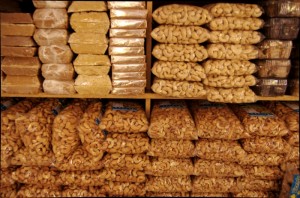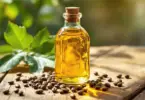Guest writer for Wake Up World
Traveling around the world shows that the presence of fast-foods is increasing at a worryingly large scale. However, while eateries of the likes of McDonalds are scattered almost everywhere, it’s impossible not to notice how locals of every country are proud of their native gastronomic traditions.
Brazil is one of the fastest developing countries and, inevitably, with wealth came consumerism. At first sight, fast-foods and soft drinks seem way too popular, but we shall not forget that the country has a glorious indigenous food routine natives are proud of and is a big producer of many types of foods with precious health benefits.
[pro_ad_display_adzone id=”110028″]
1- Manioc (cassava)
A highly energetic root, manioc or cassava is one of the most popular ingredients in Brazilian cuisine. Traditionally food of the poor, cassava is so versatile and healthy that is used in many different ways. It can be boiled and presented as a side dish or replacing the potato, made as flour and offered as farofa, or as a type of starch called tapioca, that can also be steamed and had for breakfast or deep-fried and eaten for dinner. Tapioca is very popular in Northeastern states and can be found both in restaurants and street vendors who make it in front of you.
Manioc is a fundamental ingredient of Brazil’s indigenous tribes, and is rich in minerals such as calcium, iron and phosphorus, vitamins of the complex B and potassium. Absence of gluten makes it ideal for people suffering from coeliac disease.
2- Yam
Yam, or inhame as they call it in Brazil, is a root rich in health properties and very popular all over the country.
This precious root is source of vitamin B6, important in the process of eliminating homocysteine, high levels of which can damage blood vessels, and potassium, mineral that helps control blood pressure, thus reducing the risk of heart conditions. Among its benefits are also its anti-inflammatory and anti-spasmodic properties useful in case of stomach cramps. Carbon hydrates and fibers reduce the assimilation of sugars, and abundant manganese levels play an important role in energy boosting and antioxidant defenses. Moreover, eating yam makes the blood stronger in presence of dengue, malaria or yellow fever mosquito, and eases the process of expelling the virus from the body.
Along with manioca, also inhame is easy to find in every supermarket, and in a meal it can replace the potato both boiled and smashed.
3- Açai
With ten times more antioxidants than those found in cranberries, Brazilian berry açai is one of the richest sources of these important nutrients that fight free radicals. Thriving in tropical areas, açai is produced in the Amazon region and is used in many different ways, from wines to ice creams to jams, and especially for its energy-boosting juices, for every 100 g contains 250 calories.
The fruit is rich in protein, fiber, vitamin A, C, B1 and B2 and minerals such as phosphorus, calcium and iron, important to fight anemia in children, pregnant women and in patients to accelerate recovery. The high percentage of calcium, about 10 mg for every 100 g, is important in the formation and preservation of bones and teeth and for osteoporosis prevention. In the Amazon, locals like to consume açai with cassava flour and tapioca.
It’s possible to find açai smoothies in restaurants and juice places, but very often the fruit is sold dried to add to cereals during breakfast.
4- Cashew fruit
Cashew, of both sour and sweet taste, is a fruit that can be found in all of Brazil, the Northeastern state of Ceara being the biggest producer. It’s a pure concentrate of vitamin C: every 100 g contains 220 mg of vitamin C, much more than oranges and kiwis, second only to acerola. It’s also a source of vitamin A, B1, B2, B3 and minerals such as calcium, iron, phosphorus, fibers and amino acids, and its is juice recommended in cases of anemia, rheumatism, skin issues, to prevent cataract, to strengthen the bones, for its antioxidant qualities and powerful detoxing and toning properties.
The pulp is considered a “pseudo-fruit” with the purpose of “sustaining” the nuts, considered the “real fruit” of the plant.
Cashew fruit is easily available in the main supermarkets.
3- Cashew nuts
The nuts of the cashew tree (castanha de caju) are considered a delicacy. Apart from being very tasty, they also have many health benefits. Rich in fibers, proteins, carbohydrates, amino acids and minerals such as calcium, iron, phosphorus, magnesium, potassium and selenium, these nuts also contain a wide range of vitamins, from A, D, K to E and B complex, B1, B2 and B3.
Important member of the oleaginous seeds family, cashew nuts are rich in polyunsaturated fats, and thanks to high levels of zinc and selenium, play an important role in cancer prevention. Its fibers help cleanse and protect the intestinal walls, and calcium helps prevent osteoporosis.
The bark is used for extracting a strong and powerful oil with antiseptic and anti-bacterial properties. Employed also to cure injuries, ulcer, eczema and some cases of leprosy, this oil is highly corrosive and needs to be used by experts.
Cashew nuts are very popular and sold everywhere, from open markets to small shops to the biggest supermarkets.
4- Brazil nuts
Brazil nuts (castanha do Para, not to be confused with castanha de caju, cashew nuts) are one of the highest sources of selenium that may help protect against cancer, depression and Alzheimer’s disease. Their protein content is considered complete, meaning that unlike many other protein sources, they contain all necessary amino acids humans need.
Among its many benefits, Brazil nuts fight cells’ aging process, detox the system from heavy metals, improve thyroid function, prevent from diffusion of cancer cells, strengthen the immune system and its polyunsaturated fats help reduce the levels of bad cholesterol (LDL) and increase the good cholesterol (HDL), preventing the development of heart conditions.
Brazil nuts can be found in all major supermarkets in every city all throughout the country.
7- Papaya
Brazilian papaya, mamà£o for locals, is a big fruit with orange pulp that grows mainly in tropical and subtropical regions. Low in calories and rich in vitamins A, C and B complex, calcium, iron and phosphorus, papaya is very healthy, nutritious and easy to digest. It also contains the enzyme papain the helps ease digestion process, particularly important for people with digestive problems or pancreatic insufficiency. Eating papaya after a heavy meal will also reduce the feeling of an upset stomach.
Its sweet and gentle taste makes it perfect for smoothies, desserts, ice creams and to be used for cooking, or in alternative, it makes for a delicious snack simply enriched with some lime juice to enhance its flavor.
Papaya fruit is sold both in supermarkets and open local markets, and all restaurants have a freshly squeezed papaya smoothie among the beverages in their menu.
8- Coconut water
Coconut water is contained in coconuts when they are not fully ripe, and is the best selling product along Brazilian beaches. Possibly the healthiest and most natural beverage, coconut water is energizing, refreshing and extremely rich in vitamins, enzymes and oligo elements, ideal especially during hot summer months. Coconut water, not to be confused with coconut milk, obtained by ripe coconuts and richer in fats, is very detoxing and helps cleanse stomach, kidneys, intestine, and keep body tissues constantly hydrated contributing in preserving a young skin.
Thanks to its abundance of minerals and vitamins, coconut water boosts the immune system and, unlike milk, its low level in fats makes it ideal also for who is on a weight-loss diet. Rich in magnesium and potassium, it also helps fight cellulite.
9- Guarana
Guarana is a type of vine native of South American rainforest. Its high levels of caffeine, some three to five times more than coffee itself, make it a strong stimulant and the best herb to provide an immediate energy boost.
Ground extracts of guarana seeds are available in every supermarket in Brazil, either mixed with breakfast cereals or to drink with water. Rich in tannin, they also help in case of digestion problems as its astringent properties create a protective layer against potential gastrointestinal irritations.
Apart from being an antioxidant, anti-inflammatory and diuretic, other benefits of guarana include easing migraine and improving memory performance.
10- Guava
Of sweet flavor, very popular in the form of jam to be combined with the typical cheese from Minas Gerais, queijo mineiro, guava fruit, or goiaba, can also be found in smoothie and ice cream forms. It boasts countless health benefits, such as treatment of constipation, dysentery, cold, high blood pressure, skin care problems.
Guava is rich in calcium, phosphorus, potassium, essential oils, flavonoids and carotenoids, along with vitamins A, B1, B2, B6 and C. Its anti-bacterial properties have proved to be effective also with salmonella bacteria, its fibers prevent from absorbing fat and help eliminate bad cholesterol, while its juice is recommended to reduce the level of glucose, precious for controlling diabetes.
Not only the fruit, but also its leaves are used for their medicinal benefits, both taken as a tea and chewing them raw. The advantages of tea with guava leaves range from helping in case of gastrointestinal problems, dysentery, swollen ankles and feet, up to being used as a remedy in cases of cholera and tuberculosis.
11- Black beans
Black beans can probably be defined Brazil’s national pride, as feijoà£da is the national dish that can be found in every Brazilian state.
As a legume, black beans have amazing protein and fiber content: every cup of beans has 15 g of proteins and 15 g of fibers, quality that, combined with a high presence of folic acid and magnesium, has huge benefits for the digestive tract, help protect the cardiovascular system, regulate sugar levels in the blood and prevent from the formation of free radicals. The high presence of fibers is also linked to the power of reducing the level of bad cholesterol by easing the elimination of bile acids. Important source of manganese, this element acts along with a whole series of enzymes towards the production of energies and antioxidant defenses.
A combination of black beans, rice and farofa is a very popular Brazilian dish.
12- Yerba mate
This controversial herb grows in many South American countries where natives have been drinking it for centuries, and is available in Brazilian supermarkets in the form of tea in many different flavors. Among the dangers of yerba mate, researchers have listed alleged risks of developing esophagus, neck, throat and bladder cancer, over-stimulation and possible negative interaction with drugs and medicines. Although it’s always recommended to consult an expert before a large consumption, this plant is also known for its several benefits.
According to researchers of the Federal University of Santa Catarina, Brazil, yerba mate infusions help reducing the levels of LDL, “bad” cholesterol, and increase HDL, “good” cholesterol.
Source of vitamins A, C, E, B1, B2, B3 (niacin) and B5, of minerals such as calcium, manganese, iron, selenium, potassium, magnesium, phosphorus, zinc, tannins, carotene, fifteen amino acids, polyphenols, fatty acids and chlorophyll, yerba mate is rich in antioxidants and helps fight many disorders. Natural stimulant thanks to its caffeine content, this plant has rejuvenating and energizing effects for both physical and mental stress.
About the Author
Angela Corrias is a travel writer, blogger and photographer. In her articles she always tries to combine her passion for traveling with a socially aware writing. She regularly updates her blog Chasing The Unexpected from any corner of the planet. Or stay up to date with Angela via Chasing The Unexpected’s Facebook Page
[pro_ad_display_adzone id=”110027″]







